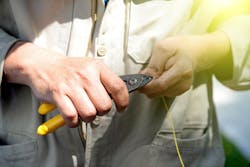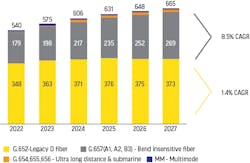Why the Quality of Fiber Can Make or Break Network Infrastructure
We’re now three years on from the pandemic that changed everything. While lockdowns and empty streets might already feel like a relic of times gone by, many of the changes that occurred during that period have endured. Many of those changes center around connectivity. While some businesses launch return-to-work initiatives, hybrid working remains a top priority; retailers have pivoted toward cloud-based technologies to engage their customers and make their businesses more resilient; cities have accelerated their transformation into cloud-based smart hubs to run their services; and fiber to the home (FTTH) is becoming a necessity rather than a luxury for many households.
Quite simply, our need for connectivity has accelerated tenfold, putting the spotlight firmly on the rollout of new digital infrastructure to fulfill it. Governments and network providers are under increased pressure to deliver new connectivity infrastructure at record pace, but high demand coupled with economic turbulence has created an environment full of uncertainty. The demand for new network infrastructure is worldwide. The global network infrastructure market surpassed $95 billion in 2022 and is projected to achieve a CAGR of around 6% in the next decade, according to Global Market Insights. This surge in growth will be difficult for network providers to keep up with, not least due to long lead and delivery times on components owing to supply chain disruption.
Broadband and 5G deployments will all face the same challenges when it comes to supply and demand, prompting providers to re-evaluate their resourcing operations, budgets, and timelines. Attention will turn to sustainability, not necessarily in terms of the environment, but in terms of creating long-lasting networks that can be sustained decades into the future. Using sub-par components to get a project over the line quickly will only prove more costly in the long run. To that end, the quality of optical-fiber cabling is going to be absolutely crucial in the rollout of new infrastructure in 2023 and beyond.
Pursuing digital connectivity during a time of disruption and turbulence
Closing the digital divide between rural and urban areas has become a top priority around the world. The need for FTTH and edge-based computing is also high on the agenda as new use cases emerge and towns and cities seek to modernize their approach to connectivity. While few would dispute that these were worthwhile objectives, the planning and deployment of the supporting network infrastructure remains a civil engineering challenge for a number of reasons.
One such challenge is the procurement of high-quality optical-fiber cabling, which is core to the success of any connectivity project that hopes to stand the test of time. While there is no shortage of optical-fiber cabling, major economic and geopolitical developments – including increased inflation, supply chain disruption, and war in Ukraine – are all having an impact on the procurement and delivery of high-quality optical-fiber cabling around the world. Supply of some of the raw materials used in the development of optical-fiber cabling, such as helium and silicon tetrachloride, has also been disrupted – which has the potential to slow network rollouts further still, albeit on a temporary basis.
In a bid to solve this particular challenge, the U.S. recently announced a new “friend-shoring” initiative. Friend-shoring is an evolved form of off-shoring, in which the likes of the U.S. and Europe will partner with companies that share similar norms and values make the global supply chain more resilient and less susceptible to geopolitical conflict. The effectiveness of friend-shoring won’t become apparent for some time, but it speaks to the temporary nature of the supply chain issues the world is currently experiencing.
While supply is disrupted, one thing is for certain – demand is high and will remain so for some time to come. Despite the tumult of the past three years, demand for optical-fiber cabling has been rising steadily to meet the growing appetite for connectivity. According to our research, demand has risen by an average of 6.5% in all regions post-pandemic, with India and North America experiencing the highest increase in demand at 17% and 12% respectively.
Supply chains will bounce back to meet the demand, but what this short-term supply chain disruption will trigger is a new focus on quality over quantity for network providers. By sourcing high-quality optical-fiber cabling and “doing the job right,” providers will ensure that their infrastructure rollouts will stand the test of time and provide a worthwhile return on investment. The alternative option, which involves sourcing legacy components and sub-par optical-fiber cabling, will be unpalatable for many governments and civil project leaders as it will only add further cost and uncertainty into the mix.
Why the quality of optical-fiber cabling is paramount
With the increased pressure service providers are under to deliver network rollouts in a timely manner, they would be forgiven for looking for alternative supply sources to meet deadlines. There are some less-than-scrupulous suppliers out there that have been quick to take advantage of this fact, offering reduced-quality optical-fiber cabling at a lower price. However, sacrificing quality in a bid to get projects over the line is a recipe for disaster – whatever is saved in cost and time is lost through the need for constant upkeep and maintenance.
For instance, some service providers have resorted to laying legacy cables originally used to equip 3G networks in modern infrastructure rollouts. Bending optical-fiber cables causes significant stress to the material, but newer iterations can withstand such conditions with no data loss or latency – for a while at least. While it may be tempting to consider cables such as “bend-sensitive” D2-type optical-fiber cables in today’s installations, the micro-fissures caused by bending will ultimately cause permanent damage, which in turn results in significantly shorter lifecycles. What this means in the medium and long term is worse performance, more repairs, and higher maintenance costs – all once the cable is already in the ground and is far harder to fix.
Optical fiber quality and network optimization
When it comes to laying networks that will support the connectivity needs of generations to come, legacy optical-fiber cabling simply isn’t a viable option. The virtualized, automated networks of the future will need longevity and speed, and if the right optical-fiber cabling isn’t selected it is ultimately providers and end-users that will pay the price.
Laying optical-fiber cabling should be a one-time project rather than a constant drain on time and budget. Gone are the days when data centers were the reserve of cloud hyperscale providers. Today, companies themselves are building multi-tenant data centers, increasing the need for reliable and robust components to power physical networks. As 5G coverage expands and FTTH continues to surge, the need for high-quality optical-fiber cabling in urban communities will also become vital.
If those in charge of deployments use sub-par, legacy optical-fiber cabling to deliver on the above expectations, every party involved is going to end up disappointed. Providers will lose resources through the need for regular maintenance and troubleshooting, cities and businesses won’t be able to realize the use cases that have been promised to them, and end-users will have to cope with a poor user experience. Instead, project managers should seek to future-proof their networks by opting for materials that will work with both 5G and 6G technologies, which can be operated and maintained with smart analytics technologies to ensure they are running efficiently and that issues can be identified immediately, or even before they occur.
The rollout of optical-fiber networks is an incredibly complex business with numerous moving parts. Often, projects can involve hundreds of suppliers from all around the world, and if just one of those supply sources is disrupted it can have a detrimental impact on project delivery times. But providers must see the bigger picture instead of opting for a “quick fix” alternative. Instead of keeping costs down and rushing through a project, they should consider a more holistic approach to optimizing their deployments that looks beyond the here and now, toward a future where the infrastructure on which our connectivity is founded is robust, resilient, and able to cope with use cases that are yet to be realized.
PAUL ATKINSON is CEO, Optical Network Business, at STL.
Paul Atkinson | CEO, Optical Network Business, STL
Paul Atkinson is CEO, Optical Network Business, at STL.


